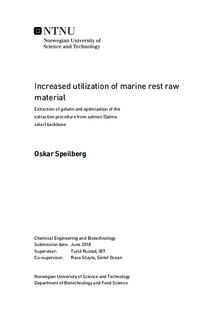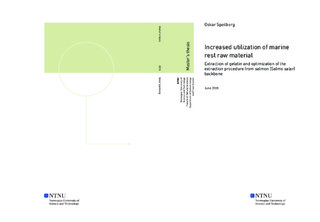| dc.description.abstract | Every year large amounts of marine rest raw materials are produced worldwide, including Norway. In 2015 the total marine rest raw material produced in Norway was 676 000 tonnes. This amount is expected to increase every year with the increase in production from the marine industry. The majority of this rest raw material is used for production of low value products such as silage or bioenergy. Currently only small amounts are utilized for production of high value products, like oil and fat for human consumption. The increasing global population creates a demand for a higher food production. There are several options to meet this demand to increase the supply of food, either by increasing the production, better utilizing the raw material, or changing people s diet. Due to this there has been an increased interest in utilization of rest raw materials.
The aim of this project has been to study the possibility of utilizing marine rest raw materials from Atlantic salmon backbone (Salmo salar) for production of gelatin, a high value product for human consumption. This project built on results from a project performed fall 2017, which was focused on running trials on an extraction method by Arnesen & Gildberg (Arnesen & Gildberg, 2007), modified by Sintef Ocean. The project was performed in co-operation with Sintef Ocean and NTNU under the DAFIA project.
The pre-treatment consisted of a seven-step acidic procedure, followed by a two-step extraction. The extraction of gelatin was performed thermally in water. The goal was to study how varying the parameters of the pre-treatment and extraction influenced the yield, purity and physiochemical properties of the extracted gelatin.
The different variations of the extraction procedure did not significantly influence the yield or purity of the extracted gelatin. Gelatin yield was found to vary between 25.9% and 34.2%, with a purity of 75.5% to 83.3%. The procedure that consisted of 10 minutes shorter pre-treatment steps was found to give the highest yield (34.2±5.75%). This sample also had the second highest purity, which was found to be 81.6±10.3% of freeze dried sample. The basic method was found to give a yield of 29.5±1.6% and a purity of 80.5±5.8%. All samples had a total amino acid content at around 1000 mg AA/g sample, which further reinforce the assumption of a high purity. No statistical difference (p < 0.05) was found between the yield and purity of the samples based on the extraction and pre-treatment parameters.
The dry matter content of all extracts was found to lie between 1.5% and 2.5%. Results of SDS-page indicates that the gelatin contain considerable amounts of peptide fragments with a size of 669000 Mw, and between 440000 Mw and 232000 Mw. The high molecular weight distribution was reflected in the gel forming properties for the gelatin, which formed strong gels at low temperatures (4 °C). In addition, the gels were found to have a low melting point (~15 °C). The physiochemical properties were shown to be good, and followed the expected properties of cold water fish gelatin. Based on these result, gelatin extracted from salmon backbone by this method produces gelatin with high purity and good yield and is likely to have areas of application in food, pharma and cosmetics. | |

